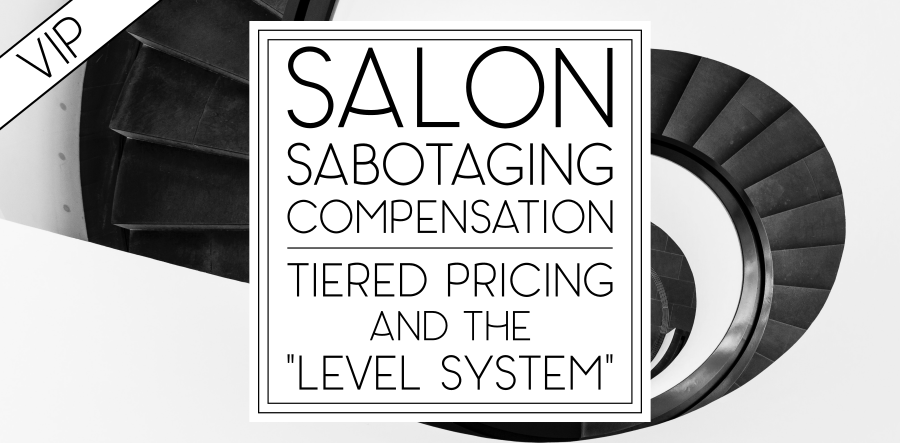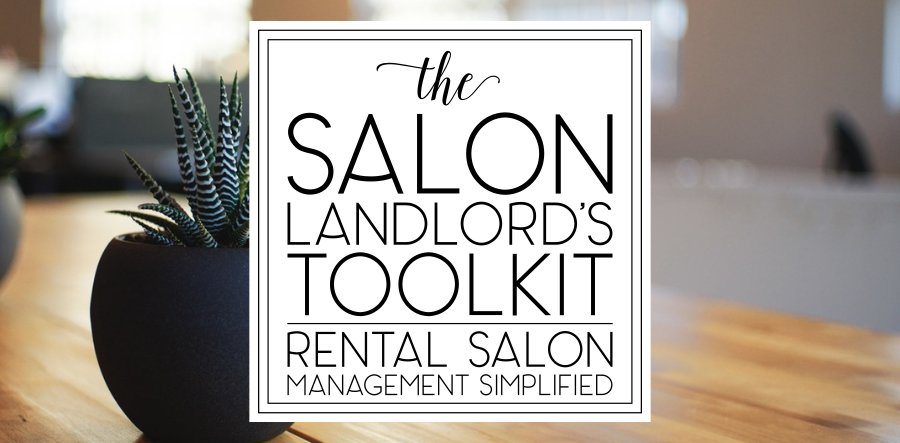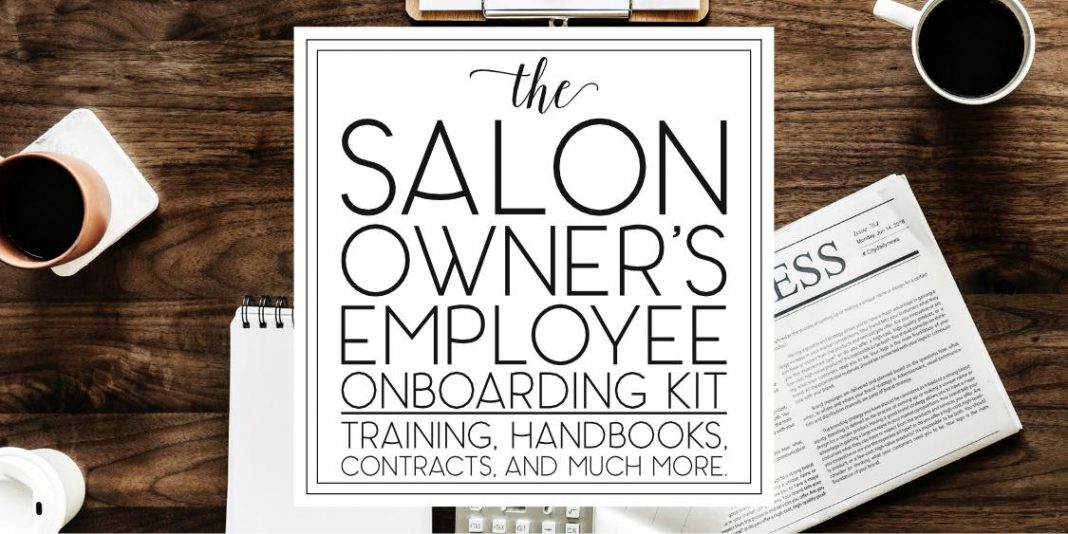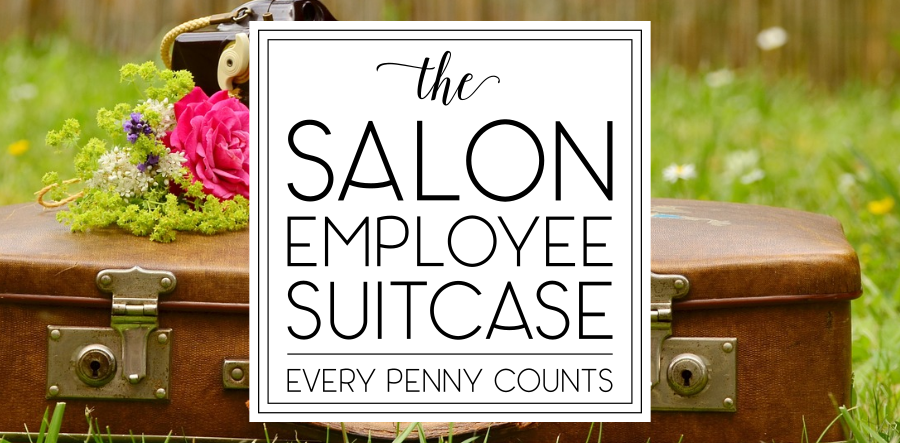Decades ago, tiered pricing (the “level” system) became trendy. It started with good intentions and what seemed like a well-considered approach. The philosophy of the model revolved around the belief that professionals with superior skills should charge and be compensated more for their services. So, salon owners placed their professionals in different skill levels, assigning labels to them like “apprentice,” “associate,” and “master.” Their menus displayed several different prices for each service, their values being determined based on the skill level of the person performing it.
Seems like a decent idea, right? Your senior professionals are happy because their superior skills are being rewarded and recognized. The investment and liability from your lower-skilled workers gets offset by their lower cost. (In addition to charging less for their services, many tiered salons were paying those professionals less.) Ultimately, this system just doesn’t work in practice the way it seemed it would on paper.
Salons that essentially rank their professionals in this way give clients the (correct) impression that their professionals aren’t of equal technical competence.
Why would you have anyone performing services on clients in your salon if their skills fell below what you would expect of your most capable licensed professionals?
This system enables managerial laziness by presenting subpar hiring standards and mediocre employee training as some kind of strategy. It excuses poor technical skill by appending a lackluster job title to those professionals and pricing their services accordingly. Clients should expect that they’ll receive the same quality of service, regardless of whose chair they’re sitting in.
Finally, for a system seemingly designed to increase morale, it tends to do just the opposite. For every “senior” who feels validated exists a handful of “associates” and “apprentices” who feel undervalued.
To make matters worse, promotions initially tend to cause more stress for the professional than they alleviate. When they “move up,” they must contend with their own clients, who may be frustrated that their service prices suddenly—and from their perspective, arbitrarily—increased. They might be happy for their stylist, but the clients may also feel that they’re being punished, especially since their willingness to repeatedly sit in that professional’s chair despite her mediocre abilities lead to that promotion in the first place.
It doesn’t stop there. Employees may not agree with the promotion of one of their coworkers. Some apprentice level professionals may get angry to see one of their colleagues promoted before them. Some senior level professionals may not appreciate a coworker they consider to be less skilled being promoted to their tier.
Ranking professionals by skill level introduces more toxic competition to an industry already plagued by it.
Instead of creating “levels” and complicating your pricing (and your work life), I recommend keeping your prices and job titles consistent, and allowing your employees’ individual merits, qualifications, and contributions to inform how you compensate them.
Alternatives to the “Level” System
Performance-Based Compensation
To encourage and reward performance, I recommend first implementing a performance-based compensation structure. These systems can be configured a variety of ways, but most commonly, commissions are contingent upon the professional exceeding sales goals.
For instance, professionals would not be eligible for commission bonuses at all until their sales exceed a particular dollar amount—referred to as the Tier 1 Goal. Until they hit that goal, they only receive their base hourly wage (and their tips, if your salon accepts them). If their sales exceed the Tier 1 Goal, they receive their hourly base wage plus a commission bonus on all of their sales. Typically, these commissions are modest—ranging from 3-5%.
The professional could then strive to hit the Tier 2 Goal, which would make them eligible for an even higher commission percentage. (Often, Tier 2 bonuses range from 5-8%.)
You could create as many tiers as you like, but most salons stick with three. (Tier 3 bonuses range anywhere from 8-15%.) However, these systems are highly individual. Salon owners need to be evaluating their own businesses, utilizing their own numbers, to determine how to best structure the system so their services are profitable. (The Salon Compensation and Pricing Megakit contains the tools necessary to run those calculations easily.)
Base Wage Increases
Instead of raising commission compensation percentages (which is tremendously expensive and does nothing to incentivize superior performance), raise base wages when a professional has demonstrated that they deserve it.
Increased bonuses reward sales performance. Increased base wages reward superior work ethic.
Performance reviews should be held on a quarterly basis. Employee raises should always be justified by more than sales performance alone. As employers, we should be requiring our professionals to convince us they deserve to be compensated more, and recognizing and rewarding them when they’ve demonstrated to us that they’re worth more.
Expanded Responsibilities and New Job Titles
When it comes to awarding new job titles to professionals, “new” doesn’t mean “arbitrary” or “symbolic.” These new titles must come with expanded responsibilities that leverage the employee’s strengths. Typically, professionals are promoted to supervisory or education-related roles.
For example, if you have an employee who is passionate about product and sells retail like nobody else in the salon, that employee should be named the salon’s Procurement Manager and given responsibilities that include: new product testing/research, salon product education, and inventory management. As a Procurement Manager, the professional would be authorized to host demonstrations for clients and employees, educating them about the products the salon carries. They would also be compensated for attending product workshops and presenting their findings to the purchasing authority in the salon, ensuring the business always has the newest and best products the industry has to offer.
Promoting employees this way not only gives them a sense of upward mobility that most salons lack, but helps to alleviate managerial burdens from the owner and/or management. Additionally, employees feel recognized, appreciated, valued, and trusted, which reduces turnover considerably and gives the professional a sense of pride and partial ownership.
The more employees who treat your salon as if it were their own; the better.
Transitioning From the “Level” System
Communication
Before implementing any significant operational and/or compensation changes, you’ll need to communicate with your current employees and clients.
Even if the changes are necessary and completely non-negotiable (for instance, in cases where the services are not profitable or barely profitable), try to keep the discussion focused on the positives. Be honest and sympathetic about any potential negatives, but reassure everyone that your decisions weren’t made on a whim.
“A lot of thought and consideration went into designing a new system that will work best for everyone and ensure the continued success of the salon.”
Clients will likely take the change much better than the employees will, as customers tend not to like the “level” system whatsoever.
Employee communication will need to be prioritized, so start the conversations three months before you plan to switch over to the new system. Failure to discuss these changes in advance and listen to the ideas and concerns of your professionals will likely lead to significant turnover. They should be made aware of which changes won’t be negotiable and which are still open for discussion.
More than anything, employees will want to know how the changes will impact them, so have that information prepared in advance. Give them the ability to schedule one-on-one meetings with you to present their concerns and ideas, and to have any of their questions answered.
Training
Employees who are ranked lower in the salon (anyone ranked below your “master” level professionals) will need to have their technical skill evaluated and any deficits corrected before the change occurs. Should those deficits not be resolved by your deadline, the professional should not be permitted to perform any services they aren’t capable of competently executing until they’ve successfully completed training.
The clients of these professionals should be made aware during the months leading up to the switch that this training is taking place. While the prior system is still in use, trainers will be actively observing, evaluating, and educating the professional.
“We’re excited to announce that we will be conducting several months of rigorous advanced training. During your appointment, one of our trainers may observe, evaluate, and educate your professional to help refine their technique.”
Recruitment
From the day you decide to make the transition, your recruitment and onboarding processes will need to change. Professionals who do not demonstrate the technical proficiency you expect from every other professional you employ will need to be trained—or not hired—until they do.
Stop hiring unqualified (or underqualified) people. Expect better.
This may mean implementing applicant evaluation procedures and structuring a training program for new hires. During their training period, employees would only be permitted to perform the services they’ve proven they can execute proficiently.
Culture
For this system to be as effective as possible, salon owners will have to work hard to establish and maintain a positive, productive, supportive salon culture. While the compensation system does a good deal of the heavy lifting, it’s up to the employer to create a culture that motivates and enthuses professionals so they feel more invested and as if they have a degree of ownership and control over their own success and that of the business.
During the months leading up to the transition:
- become more diligent about showing gratitude routinely
- practice active listening when communicating with employees
- strive to create an atmosphere where employees (especially your trainees) feel comfortable seeking help and admitting their limitations
- complement the skill of your professionals by remarking on service outcomes daily
Transitions of any kind can be rough, especially those that essentially redefine a business, so don’t expect everything to go smoothly. You will likely lose a few employees and clients. You’ll have doubts. You’ll probably experience some fear and anxiety. Just remember that one day, it will be over and you will come out through the other side—and your business will be better off for it.
How does your compensation strategy reward and/or encourage your employees? Do you use a similar ranking system, assigning different prices to different employees? Does it work well, or has it presented challenges/complications you didn’t anticipate?









8 Responses
This is very interesting and I’d like to learn more about what alternative you could see work. Can you please expand on how you would address the things that the level system tried to solve in the first place: how do you allow your senior staff progress in their career and earn more (not just from being busier but from a higher level of skill) while also creating an environment that motivates and promotes more junior professionals? It seems to me that by not having any differences in price, it’s solving one problem but could maybe create others?
About five years ago, a good deal of my consulting clients were choosing to shift away from the “level” system. Under the level system, professionals found the system to be unfair and employers found it unbalanced, since employees were awarded for inevitable accomplishments (like attainment of seniority or technical proficiency). Basically, it wasn’t encouraging or rewarding the right behaviors.
We implemented a few different strategies and monitored the outcomes and feedback from both professionals and managers. Those strategies included:
1.) performing routine assessments and assigning wage increases (not price increases) to deserving professionals,
2.) structuring bonus systems that reward superior performers with higher commission rates (making the bonuses contingent upon the attainment of sales goals, similar to structures found in other sales-based businesses),
3.) giving exceptional professionals new job titles and expanded responsibilities (typically supervisor and/or technical educator status).
These solutions ranked favorably among the professionals, encouraging them to strive to attain sales goals and earn bonuses and promotions. These systems also encouraged them to take more interest in their schedules and focus more on upselling and on client retention.
a.) Since increased idle hours negatively impacted their ability to hit their goals, they were more likely to speak with management about streamlining their work hours and/or finding ways to become involved in the salon’s marketing plan.
b.) Since they were no longer being awarded higher commissions for every service and had to actually earn those bonuses, upselling became a priority.
c.) Since retention factored into their overall performance assessment, professionals became more diligent about rebooking and securing standing appointments.
Switching to a performance-based system resulted in every professional showing interest in their own performance. They monitored their numbers daily, sought assistance with improving their metrics (both from within and outside of the salon), and became more involved in the salon’s success overall.
I can’t at all take credit for this system, as it has been in place in many corporate salons since the mid-90’s, but I can take credit for making it more functional and effective. The corporate systems that turned so many professionals and salon owners off to the entire concept were severely flawed, offering professionals exceptionally low wages and low bonuses while also requiring them to maintain obscene performance levels. They had few systems in place for promoting employees and giving them more responsibility, and those pathways they did have involved putting the employee in intensely thankless and low-paid management positions that usually required them to give up doing the work they love. Because corporate salons are corporate salons, both professionals and management typically had little to no control over the salon’s marketing and were helpless to do much at all to increase traffic and boost their metrics. As someone who spent years working for those corporate enterprises, it was easy to see what they were doing wrong and modify it for small business owners.
There are some management strategies that play into this, though. Salon owners may also have to modify the way they communicate with employees and become more diligent about showing gratitude routinely. While the compensation system does a good deal of the heavy lifting, it’s up to the employer to create a culture that motivates and enthuses professionals so they feel more invested and as if they have a degree of ownership and control over their own success and that of the business.
Hi Tina,
I have been wanting to get away from this tiered pricing model for years, but worry about losing business, and really unsure how to transition. Is this something that you offer in consulting? (Helping to walk through the process)
Thank you!
Shannon
Hi Shannon! I spent all day making audio recordings for a bunch of articles and intentionally skipped this one so I could expand it further. On Thursday, that expansion will be done, and I will be including transition strategies that I’m positive you’ll find helpful. There’s more than one way to move away from this system and because salons are so individual, it will be necessary to find a strategy that works for your clients and employees. If the options I provide on Thursday don’t seem like they’ll be compatible with your business, or if you’d like to develop a more specific implementation plan, then we can make an appointment to work something out, but definitely wait until Thursday before booking, just in case. 🙂
Hi! The level system that I have in place seems performance based. Meaning they have to meet 4 specific criteria and take specific classes before advancing to the next level. It actually is very clear and there’s no question on whether someone deserves to advance. I’m I mistaken? However, if there’s a system that’ll motivate even more than I will def look more into it. Thank you for the information!!
It’s nice to see systems that are structured in ways that aren’t arbitrary, so in that respect, your system makes more sense than most. However, if the professionals are all operating at different price points, you’re likely overcomplicating things unnecessarily.
Hi Tina,
I have many opinions and comments on this topic, firstly I want to say I absolutely appreciate what you do Tina and hope to meet you someday, and two without writing a novel, what I need to point out is that in many states, including the one I live in.. the law states employers are not required to give employees their employment agreements.
The employment agreement is what holds such pay structures and breaks things down for employees as well company policies, and most all “written” contractual benefits to any type of degree. Even though my state is an “at will state” for both employees and employers, I’ve also been told by lawyers “that it’s an employers state.” In stating just this little bit… I was negated any and all oral promised pay performances, “pay types,” and literally paid what they felt like paying me even though I had proof that the GM deleted my original hours of my on boarding time period, and picked a random date (to which I wasn’t even in the salon that day at all, or city, I was getting a certification that can also be proven) and chose random hours and lied on my time sheet to change my original on boarding date because they didn’t pay me for the hours and they didn’t give me my promised bonus for recruiting half of the salon stylists just 2 days before grand opening that they referred to as an “salon stylist performance bonus.” I had it in text from the recruiter that sought the help and made the offer.
So these kinds of systems are only really relevant to employees that actually receive their genuine offers in hand, and there are signatures and dates by both them and the employers.
Things aren’t relevant unless they have something to show proving they were actually ever told this was in deed the pay structure.
And after I voiced a complaint to the DM, my tires were slashed. After I did the “speak out to corporate.” They promised my employment agreement they just needed me to send where I was told these things and by whom as well the proof on all other matters.
After I did that as my end of the bargain, I was told via email by corporate that by law they don’t have to give me my employment agreement and to subpoena them for it. I have an interesting recording too.
I went to see lawyers. That’s when I learned it’s an employers state and there’s not enough money involved here to go up against this corporation.. that what they did is wrong but that unfortunately there’s no law saying they can’t be rude, that I wasn’t 40 yet, I was 39… 40 now and within the number of days to report buy told had to be 40 on the day of retaliation and age discrimination, and that they didn’t have to give me my employment agreement. I said they took my information and altered it to accommodate themselves. They committed fraud, they fraudulent altered multiple documents.
Bottom line… it didn’t matter and moral of the story, I didn’t matter.
The fact is I messed up. I didn’t think to demand on day one the GM give me my employment agreement when she stated “it’s too many pages and stated she had copies” in her car… I should have said unacceptable I need the original or not accepted the job and warned the others.
The police are still trying to obtain the video of the men I witnessed the night my tires were slashed in June.
The police in another city are still investigating the identity fraud I suffered and still suffer right after I quit that job when I realized what they were doing and I witnessed my GM fraudulently alter my check to accommodate herself from trouble not paying, covering that she and the salon manager collected my bonuses, and last but not least that she wanted our store to rank in higher sales and in order to do that stylists have to have less missed days and the store has to show more sales in service in a shorter period of time. We won that period. That means quarterly bonus for her and the salon manager.
And as for me… I’d have to sue in their Corp state. Far away.
I lost so much.
I now rent…. and have so many questions and feel bitter.
I have zero healing and zero understanding as to how this is professionally possible and or legal. I never even saw the employee handbook. Yet expected to just know what it all entailed….
You’re absolutely right that this type of information really is only relevant to people who have written offers, which is why I ALWAYS recommend never accepting any position without one. (Not just the offer letter, but a copy of the employee handbook and any other agreements you’re asked to sign.) Unfortunately, it’s extremely typical of companies that exploit workers to make excuses for why they can’t provide that documentation. Sometimes, it’s a matter of policy (in small, single-location salons). In others, it’s the deliberate action of a bad manager (which we see often in large, corporate salons that don’t want to be associated with those bad recruitment tactics–or get sued).
While it’s unlikely to make you feel better, this doesn’t just happen in our industry. Workers in all positions in every field across the world get scammed, mistreated, and exploited all the time. The best we can do is be skeptical and demand accountability when we can. You did the right thing. It’s unfortunate, but you really can’t trust anyone or take them at their word. A good employer won’t expect you to.